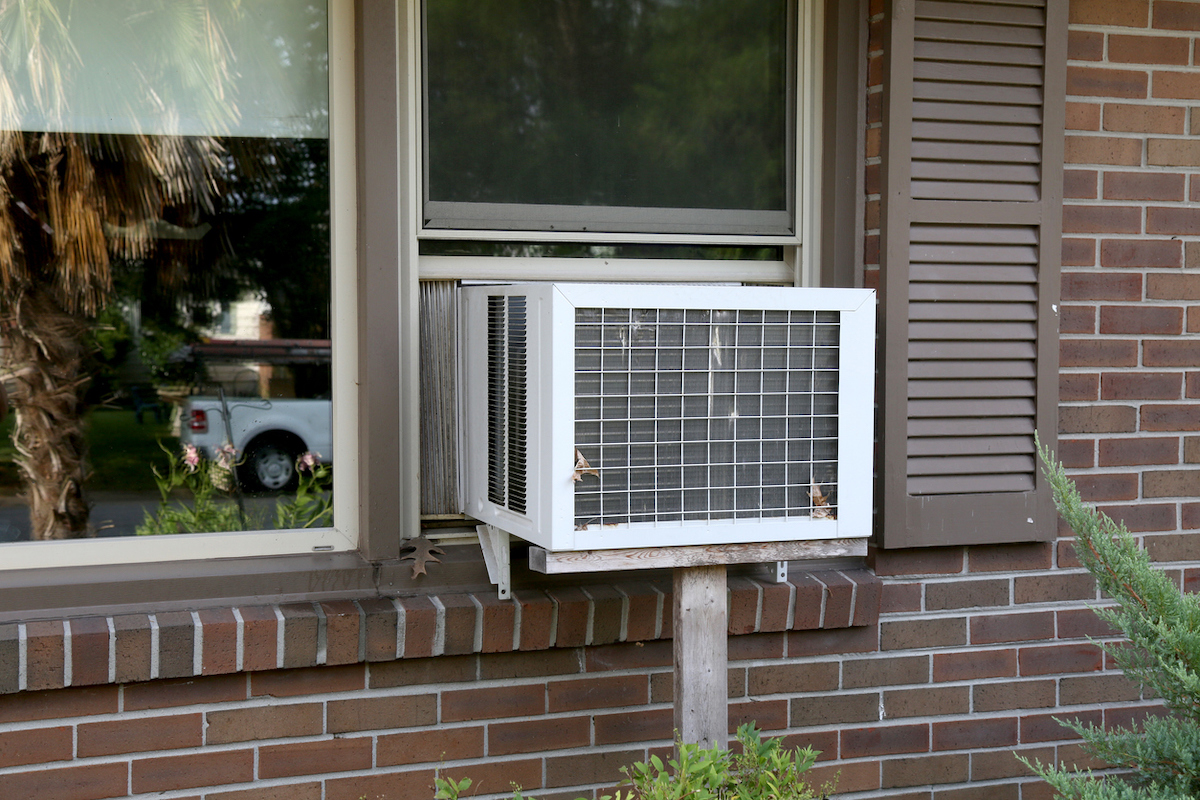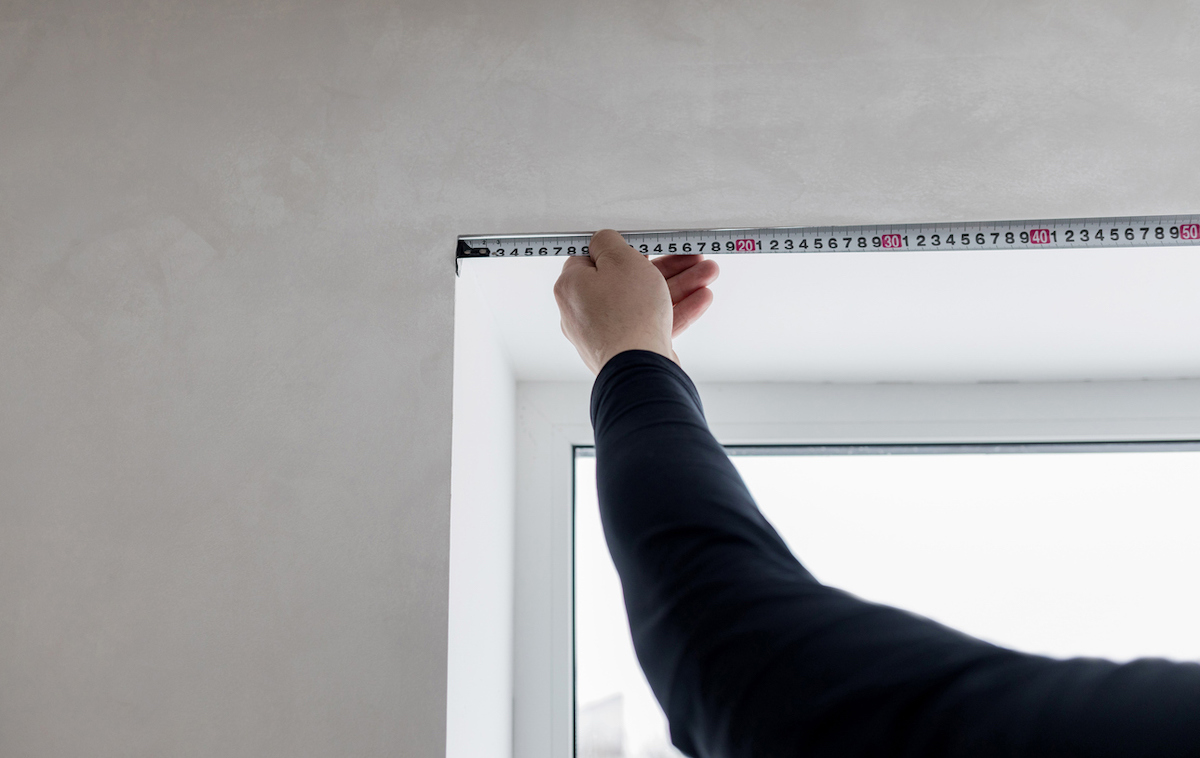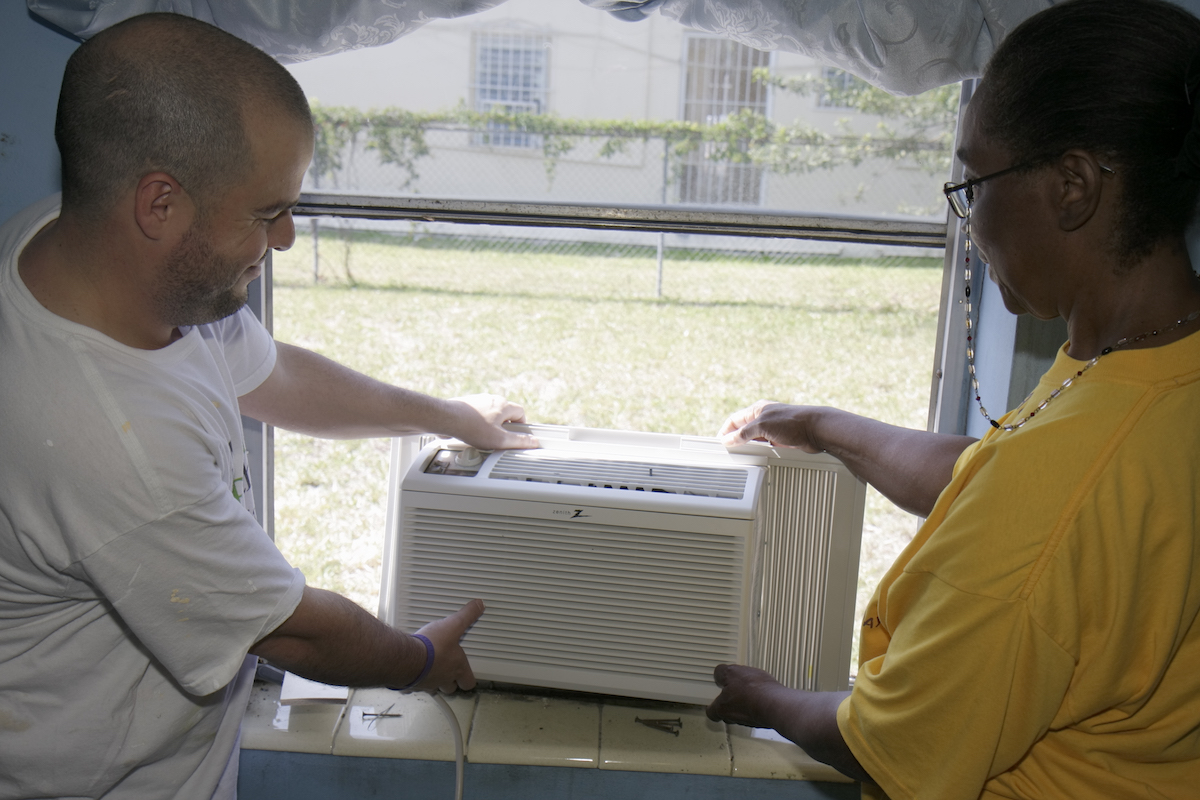We may earn revenue from the products available on this page and participate in affiliate programs. Learn More ›
If sweltering days and nights without central air conditioning threaten your summertime comfort, consider putting in a window AC unit. Installing window AC units is well within the capabilities of most do-it-yourselfers. Just be sure to plan out the project details, select the appropriate brace for the air conditioner’s size, and have a handy helper.
According to Micah Sherman, virtual HVAC expert at home care and maintenance app Frontdoor, the biggest mistake homeowners make when installing a window AC is “thinking that it’s a one-person job. Window units can be heavier than they look, and having an extra set of hands can make the installation a lot easier and safer.” These appliances are cumbersome, and they are easy to drop if you aren’t prepared. Plus, they need to be positioned correctly in order to effectively cool the space.
To learn how to get the job done safely and swiftly, follow the tips here, and then check out our guide on how to install a window AC unit when you are ready to start the project.
1. Get permission from your HOA or landlord.

While most owners of single-family homes are free to install a window AC, if you live in an apartment, condo complex, or a neighborhood with a homeowners association, check with management or the HOA board before investing in an AC unit. You may be able to look up guidelines for window AC units in your development’s covenants, conditions, and restrictions (CCRs), architectural rules, and bylaws. Even if ACs are permitted, there may be limitations on the types of window ACs that are allowed on certain elevations of the home.
When properties and HOAs don’t allow window ACs, it’s typically for aesthetic reasons (they’re not especially attractive) or safety concerns. There’s a risk that an improperly installed unit could fall from the window, leading to injuries.

Tried-and-True Advice
“When I lived in my New York City apartment, I dreaded removing and reinstalling my window AC unit every year. Instead of taking it out completely in the winter, I used a simple trick to block drafts and keep my apartment warm.
After securing the unit with an exterior bracket (a must in NYC), I cut a piece of rigid foam insulation board to fit snugly around the AC inside the window frame. Then, I sealed the edges with removable weatherstripping tape. This helped prevent freezing drafts without damaging the window, and when summer rolled around, I just peeled off the tape and was ready to go. It saved me from the hassle of reinstalling the unit every year and kept my heating bill lower in the winter.”
—Paul Rankin, Contributing Editor and Writer
2. Select the window that can best accommodate an AC unit.
Before searching for the right AC unit, you need to pick the window that will be easiest for installation and most effective for use. Not every window is suited for every type of air conditioner, and there are many window AC fitting ideas to consider. Most window ACs are designed for use with standard double-hung windows, which have two operable sashes that slide up and down. There are also AC units made for sliding windows, which move from side to side, and casement windows, which tilt outwards to open. These tips apply primarily to installing a window AC in a double- or single-hung window. Here’s what to consider when selecting the right window:
- You’ll need a three-prong electrical outlet fairly close to the window; most window units have a cord that’s only about 6 feet long. Never use an extension cord for window ACs. This could void the warranty on many air conditioners and create a fire hazard if the extension cord isn’t rated for major appliances. Especially large window ACs (more than 12,000 BTUs) may need a dedicated circuit.
- For best performance, an air conditioner should sit in a shady or partially shaded window because direct, intense sunlight can decrease the unit’s efficiency by as much as 10 percent.
- An air conditioner requires sufficient clearance for unimpeded airflow, so choose a window that doesn’t have furniture, trees, shrubs, walls, or other obstructions within 20 inches of the unit on either side of the window.
3. Measure your window and your room.

There are two sets of measurements you’ll need: the height and width of the window opening and the square footage of the room the unit will cool. The air conditioner’s packaging will typically specify both the size range of acceptable windows and the maximum square footage the unit can cool, so make sure your measurements are within the guidelines for the unit you’re considering.
- To measure the window, open it as far as it goes, and then use a tape measure to find the dimensions from side to side and from top to bottom.
- To find the square footage of the room you hope to cool, measure the length and width of the room (this is easiest if you have a helper hold the tip of the tape measure against the wall as you extend it to the opposite side), and then multiply the two numbers to obtain the square footage. For example, if your room is 11 feet wide and 12 feet long, it is 132 square feet.
4. Figure out how much power you need.
You’ll need to look at two more numbers, usually indicated on an air conditioner’s packaging, to make sure you’re purchasing the best unit for your needs.
- British thermal units (BTUs): This figure is a measure of the appliance’s cooling capacity. A larger room will need a unit with more BTUs.
- Energy efficiency ratio (EER): This number, which ranges from 8 to 12, is the ratio of a unit’s cooling capacity to its power input. The higher the number, the more energy efficient the air conditioner. The U.S. Department of Energy recommends an EER of 10 or more for the best efficiency and greatest potential savings on your electric bill.
If the air conditioner isn’t powerful enough for the space, it will run continuously without reaching the desired temperature. If it’s too powerful, the unit will tend to cycle on and off too quickly. This rapid cycling which won’t allow enough time to reduce room humidity effectively and will lead to uneven temperature throughout the space. Generally, a window unit’s BTU rating will match the AC manufacturer’s recommended room size, but to calculate it yourself, try an online BTU calculator.
5. Always have someone close by to help, and make sure no one is under the window.
Installing a window AC on your own is an easy way to injure yourself or accidentally drop the unit out the window. Always make sure there are no people or pets below the area where you intend to install the unit. Also, protect anything inanimate below that’s valuable to you by moving or covering it before starting the project.
Window air conditioners typically weigh between 50 and 100 pounds, so safely maneuvering the appliance into the window and then holding it in place while it’s being secured with screws requires a helper. It also requires good communication to make sure you both have your hands on the unit when necessary and are working in unison.
“If you don’t have the proper tools for the job or have safety concerns, such as installing the unit in a high window, then you may consider asking a professional for help,” says Sherman. “However, most of the time, these systems are simple enough to install without the help of a pro.”
6. Prepare the window and install brackets, if necessary.

Before installing a window AC unit, open the window as far as it goes, remove the screen, and clean the windowsill, glass, and window frame. A properly installed air conditioner may sit securely in the window without an exterior support bracket. But very heavy units (those more than 100 pounds) do require additional support, and some municipalities, notably New York City, require the use of an exterior support bracket for all window air conditioners, regardless of weight.
Generally, you’ll need to buy support brackets for window AC units separately. There are different configurations of AC brackets, but most resemble either a small shelf or a pair of “legs” that extend outside the window to help hold the unit in place. “The type of bracket does matter,” says Sherman. “It also depends on the type of window. A bracket can help distribute the weight of the unit and reduce stress on the window itself and the glass. L brackets are commonly used, although most units come with their own mounting brackets.”
Some window unit support brackets, such as the Ivation Window Air Conditioner Support Bracket, require no drilling or screws, greatly simplifying installation. The Ivation has an expandable bar that fits securely in the lower window frame while two rubber-tipped “feet” rest against the exterior wall to support the air conditioner’s weight. Expect to pay from $30 to $100 for a support bracket. (You can instead opt to make a DIY window AC bracket.)
7. Attach mounting rails and side panels.
Some window units come with top and bottom mounting rails already attached. These help hold the air conditioner securely in the window. If your unit does not, use the included screws to attach the mounting rails, making sure to tighten all screws completely. Here are the general steps for installation.
- Mark the center of the windowsill’s width.
- Attach the accordion-style side panels by sliding them along the grooves on each side of the air conditioner. Note that some units have side panels that screw in. (When the installation process is complete, these panels will fill in the gaps between the air conditioner and the sides of the window frame.)
- Once the mounting rails and side panels are in place, lift the window unit—with your assistant’s help—and set it in place on the windowsill.
- The bottom mounting rail should fit into the lower window frame, helping to position the air conditioner correctly and hold it in place.
- Line up the middle of the air conditioner with the mark you made at the center of the windowsill.
- Have your assistant hold the window unit steady while you lower the open window sash until it sits on top of the air conditioner with the unit’s top mounting rail resting in front of the lower edge of the sash. This serves as another safeguard to keep the window unit in place.

Is the AC unit installed securely?
After the AC unit is in the window, it’s time to make sure the unit is securely installed.
- Install the L-brackets. While your assistant holds the window unit in place, use a power screwdriver or drill to install the L-brackets, small, L-shaped hardware that locks the sash in position and serves as a final safety measure to hold the air conditioner in place. Screw one side of the L-bracket into the top of the sash that is holding the AC, and screw the other side to the face of the window frame. This will prevent the window from opening and causing the unit to fall out. Depending on the manufacturer, your air conditioner may come with one or two L-brackets.
- Fill the gaps around the AC unit. Use the foam seal that was probably included with the unit to fill the gap between the two window sashes. This prevents the cooled air from escaping and the warm air outside from getting in. Sealing this gap also saves your window unit from having to work harder to control the indoor temperature and prevents moisture, dust, and insects from entering your house.
- Extend the accordion side panels. Pull out the side panels of the air conditioner until they reach the sides of the window frame. Use the screws that came with your air conditioner to secure the side panels to the window frame, using a power screwdriver or drill, if necessary.
8. Measure the unit’s tilt.
Many window units require a very slight tilt away from the building to prevent condensation from puddling down the wall inside your home. Typically, the tilt shouldn’t be more than half an inch, which can be achieved by sliding a shim or two underneath the base of the AC, but check the installation guide for the manufacturer’s recommendation. Some newer units don’t require a tilt, as the manufacturer has installed the drip pan at a slight angle.
Now that your window AC unit is installed, it’s time to test it out. Plug it in, turn it on, and enjoy the cool relief from summer’s heat.

